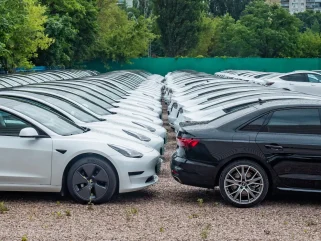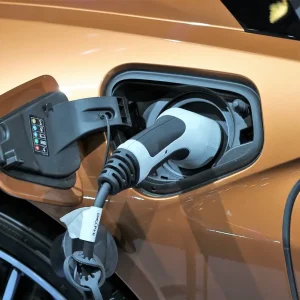
“You might have had a difference of £10/15,000 two, three, four years ago, between a BEV and an ICE vehicle. Whereas now, in some instances, a BEV is actually cheaper.”
That’s Indicata’s head of sales, Dean Merritt, on what has happened to used electric car prices. Values were traditionally much higher than those of petrol and diesel equivalents, which did not exactly generate demand among buyers. Couple that with an overall reduction in used car prices, as they slipped from their artificially high post-pandemic levels to something closer to normal, and the market’s supply and demand laws decreed that EV prices would head south.
That began 21 months ago according to Cap HPI, which says that values of three-year-old/60,000-mile EVs dropped by 57% in that period, compared with 12% for petrols. At its peak, the fall heralded a spate of dealer buying bans and big worries for leasing companies as values nosedived.
Used EV values have since settled down and are now, generally, much closer to their petrol and diesel equals. The Vehicle Remarketing Association noted as much in March, when it said EV prices were “stabilising once they reach price parity with their ICE equivalents”, and, in some cases, EVs now cost less.
Quarter one trade prices from Manheim Auctions showed an average of £16,654 for a two-to-four-year-old battery electric car, compared with £18,063 for an equivalent diesel – a 7.8% difference. Comparable petrols sold for £12,980, 28.3% and 39.2% less than EVs and diesels respectively.
EVs were still much more expensive when compared with ICE models across all age groups, averaging £16,829 in quarter one next to diesel’s £6,051 (-64.0%) and petrol’s £6,108 (-63.7%). However, this was disproportionately weighted to newer, more expensive EVs and older, cheaper ICE models. Two-to-four-year-old used cars represent prime stock for franchised dealers and fleets, and leasing companies are more likely to dispose of them on a regular basis.
In quarter one of 2022, when used car prices were much stronger, Manheim’s average EV trade price was £21,302, diesel was £19,930 (-6.44%) and petrol was £15,728 (-26.2%).
“Petrol and diesel [prices] are remaining fairly firm,” says Philip Nothard, insight director at Manheim’s parent company, Cox Automotive. “We’re at this place now where EV [values] are coming down but, at the same time, petrol and diesel are stabilising.
“As they become rarer and rarer, the prices start to firm up, so you actually get a strengthening of ICE products as EV comes down. You get this price parity by default of the two movements. That’s kind of how we see the market playing out in time.”
Data specialist Indicata says the average price of used EVs sold by its parent auction firm, Autorola, fell by a nominal 1.3% between January and March and noted an emerging reputational aspect among certain brands. By comparing the prices of five electric cars and their ICE equivalents at two years old and 20,000 miles, it revealed cases where the EV was worth more, less, and exactly the same as its ICE counterpart.
As of March, an electric Hyundai Kona (£19,700) was worth £4,700 more than the petrol and an electric MG ZS (£15,000) £1,250 more than a petrol. An electric Citroen C4 (£14,000) was worth around £2,000 less than a diesel and an electric Vauxhall Corsa (£15,250) £750 less than a diesel. Electric and petrol Peugeot 208s were identical, at £14,250.
“The Kona and the MG, they’ve stayed quite strong the market, but the Corsa and the Citroen haven’t,” says Merritt.
“What’s interesting is, it’s not the same for every vehicle. Brands that have a good electric offering – for instance, Hyundai and MG – they are still holding up. Whereas brands that maybe don’t have such a strong offering, that’s when they’ve reached parity or they’re below.”
Back in the days when they commanded large premiums, experts often said used EVs would eventually find their place in the market. It looks as though that has at least started to happen, and that the economics may be settling into a natural rhythm, which cannot be bad news. In May, Startline Motor Finance’s Used Car Tracker report claimed 53% of dealers it surveyed said EVs were much easier to sell when they were the same price as petrol cars.
However, experts are keen to stress that used EVs remain a developing market. They may have risen by 71% in quarter one, but EVs accounted for 2.1% of used car transactions, according to the SMMT, so they are still very much the minority.
Cox expects only a modest shift in the overall UK used car parc fuel mix during the next four years but stresses that remaining ICEs will just get older. Diesels, including mild hybrids, are expected to fall by 3% to a 30% share between 2024 and 2027, leaving them 14% down on the 2020-2023 used car parc. Petrols, again including mild hybrids, are predicted to be relatively static and actually increase their percentage share by 1% to 62% (the overall used car market is forecast to contract by 1.1%) leaving them 0.2% down on 2020-2023.
Used battery electric vehicles are tipped to rise by 2.5% in 2024 to a 5.9% share in 2027, up 184% on 2020-2023. Hybrids and PHEVs are expected to rise by 1.0% to 2.8%, up 110% on 2020-2023.
Many manufacturers have aggressively discounted new EVs to meet the ZEV mandate’s target of 22% of new car registrations – hardly a stabiliser. Indicata reported a 39.1% increase in sub-12-month-old cars in April, which it identified as manufacturer-backed, tactical registrations. It noted a high proportion of EVs among them which “remain locked in the wholesale market”, and that could well intensify as pressure builds later in the year.
Price drops by new car manufacturers could really rock the boat, too. Tesla, which has form here, has recently done as much in other markets to counteract stalling sales, as has BYD. Should the same happen in the UK, it would affect used EV prices.
“If you get a small reduction, it’s probably not going to interfere too much with the used marketplace,” explains Matthew Freeman, managing consultant at Cap HPI. “Where a manufacturer makes a fairly substantial reduction and a new car effectively becomes cheaper than a nearly new car, well, you can’t have that because people always expect to pay more for a new car.
“Where you get a substantial price cut and something like a six-month-old-car is suddenly more expensive [than a new one], the residuals have to move. There’s a sort of cascade effect.”
“You’ve got to be eyes wide open, watching particular brands, particular models. Some are more exposed than others,” adds Nothard, “I think the fleet sector has to be at the top of its game in terms of how and when they remarket [EVs]. You can’t just drop off at a thousand units at a single location and expect a reasonable performance.”
Europe’s tussle with Tesla
A report by Reuters in May revealed that Tesla has attempted to placate some European leasing companies, after its price cuts blunted values of cars on their fleets, while sluggish service and costly repairs left corporate customers disaffected.
The news organisation said it interviewed nine executives at major leasing and rental firms and “about a dozen” corporate fleet managers. Comments from many were not complimentary, and sources confirmed that Tesla’s pricing strategy had harmed residual values. However, they also said the manufacturer had been offering “unofficial discounts” on new cars providing they were in stock – said to be up to €2,000 for the Model 3 and the Model Y – since mid-2023. They also said the manufacturer had attempted to resolve longstanding complaints about service, repairs, and its ordering process.
According to the story, Arval deputy CEO, Bart Beckers, told Tesla, “you are really shooting yourself in the foot”, and, while acknowledging the discounts and efforts to improve service, suggested that rival Chinese EV manufacturers were focused on preserving their vehicles’ residual values.
Supported by:






